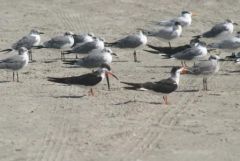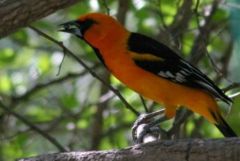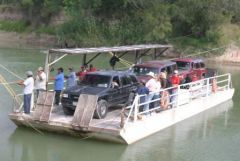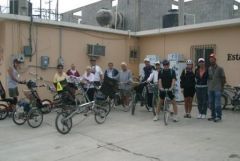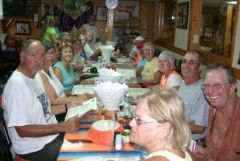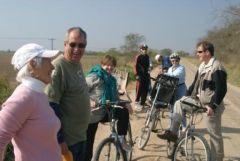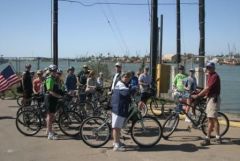-
Content Count
2713 -
Joined
-
Last visited
-
Days Won
44
Content Type
Profiles
Forums
Blogs
Gallery
Everything posted by tbutler
-
From the album: A selection of South Texas animals
In Laguna Madre at Laguna Atascosa National Wildlife Refuge near Port Isabel, Texas© @ Tom Butler
-
From the album: A selection of South Texas animals
At Santa Ana National Wildlife Refuge near Alamo, Texas© @ Tom Butler
-
From the album: A selection of South Texas animals
Found at North American Butterfly Association (NABA) International Butterfly Park, near Mission, Texas© @ Tom Butler
-
From the album: A selection of South Texas animals
Seen at Sable Palms Preserve near Brownsville, Texas© @ Tom Butler
-
From the album: A selection of South Texas animals
Common at Monte Cristo Golf Course near Edinburg, Texas© @ Tom Butler
-
From the album: A selection of South Texas animals
Seen at the Edinburg World Birding Center Site© @ Tom Butler
-

Black Skimmers, White-Winged Terns and Royal Terns
tbutler posted a gallery image in Members Gallery
-
From the album: A selection of South Texas animals
Seen at the NABA International Butterfly Garden near Mission, Texas© @ Tom Butler
-
-
From the album: A selection of South Texas animals
Seen at Bentsen State Park, now Bentsen World Birding Center near Mission, Texas© @ Tom Butler
-
From the album: A selection of South Texas animals
Photographed at the Edinburg World Birding Center.© @ Tom Butler
-
From the album: A selection of South Texas animals
Commonly seen at the Bentsen World Birding Center near Mission, Texas© @ Tom Butler
-
From the album: A selection of South Texas animals
Photographed at the Bentsen World Birding Center, commonly seen throughout the Rio Grande Valley© @ Tom Butler
-
From the album: A selection of South Texas animals
Seen at Laguna Atascosa National Wildlife Refuge near Port Isabel, Texas© @ Tom Butler
-
From the album: A selection of South Texas animals
Occasional sighting at the NABA International Butterfly Park near Mission, Texas© @ Tom Butler
-
I have a different solution for handling spam. I am on Earthlink.net and they offer an on-line address book as a security measure. If I don't put someone in the address book their e-mails will be held in a file separate from my in box. I can check this box periodically and select e-mails to be added to my address book. I have three options with e-mails that are spam, I can simply leave them and they will be deleted after two weeks. The second option is to report them as spam. In theory, they report the sender to their internet provider who would take action to shut down their site. The third option is to block all messages from a particular URL. I can use the second and third options together. The e-mail address that I have on this site is the one that I have been using for over six years. My spam messages are caught by this filter and are almost gone. Nothing gets through the filter. As a matter of course I always report spam and if possible block it. Of course I can't block something from yahoo.com because I have too many friends who use yahoo. On the other hand, I suspect that yahoo gets the message from earthlink complaining of the spamming and takes appropriate action. Everyone whose e-mail is blocked by this message gets an automatic reply letting them know their message is blocked and that they may send a brief appeal message to me. I get those in my in box and they alert me to the fact that someone is trying to reach me via e-mail. I don't get any appeals from spammers, not even from commercial advertisers. The system works great for me.
-

We start at day 1...
tbutler commented on tbutler's blog entry in Tom and Louise on Tour in North America
Wayne, They are way to eager to be paid! They will grow up soon enough. For now, I'll enjoy the Tom Sawyer role and take advantage of their youthful enthusiasm. Their pay will be trips with Grandpa and Grandma. We'll take the oldest boy in the picture and his cousin on a trip through Illinois, Indiana and Kentucky this summer. If all goes well, we'll spend 12 days with them. We plan to visit the Lincoln Home and Museum in Springfield, the Indianapolis Children's Museum, Schimpff's Candy Store and Factory, the Louisville Slugger Factory and the Zoo in Evansville. There are other stops and some time to play and ride bicycles. We'll be within a days drive of home in Missouri if the boys get homesick.- 5 comments
-
- Introduction
- Missouri
-
(and 2 more)
Tagged with:
-

A season of bicycle rides. Part 1
tbutler posted a blog entry in Tom and Louise on Tour in North America
Each season we participate in many activities at our winter home, Sandpipers Resort in Edinburg, Texas. One of my favorites is the weekly bicycle ride. Most of our rides originate as a car trip from the park to a location where we ride for several hours and then return to our cars and travel to a unique restaurant for lunch. In the process we explore nature areas, state parks and wildlife refuges. We also visit cities in Texas and in Mexico. Tomorrow will be the last ride of the season. To give you some insight into some of our winter activities, I'll describe a few of these rides. Rio Rico is an interesting town just across the Rio Grande River. In fact, the Rio Grande River used to be on the south side of Rio Rico. At that time it was part of the United States. Now it is in Mexico. The land was formally ceded to Mexico in the 1977. We park our cars on border at Progreso, Texas, and cross into Mexico on our bicycles. From Nuevo Progreso, Mexico, we ride East on a gravel road for about four miles to reach Rio Rico. Rio Rico is a small, poor community. There is a school and several churches. The children are out of school for a holiday and they come to visit us as we ride through town. We resolve to bring school supplies on our next visit to Rio Rico. When we return to Progreso we go to Arribas Restaurant and enjoy a Mexican meal on the patio as music plays inside. In the small town of Los Ebanos, Texas is another border crossing into Mexico. There is no bridge here, only a small ferry that holds three automobiles. The ferry is attached to cables and is pulled across the river by hand. Pedestrians may assist in pulling the ferry but usually only the tourists do so. We can get about 20 bicycles on the ferry alongside the three cars. Across the river a two mile bicycle ride into the town of Diaz Ordiz takes about 20 minutes for our group. We ride through town seeing homes and businesses. On occasion we have stopped at a bakery for some cookies. The church on the square has been remodeled and we enjoy touring the building. The priest visits with us explaining that the vast improvements were possible with a donation of a church member. After our ride through town we arrive at a favorite restaurant. Villarta features seafood. The menu is in English for us but the waiter speaks very little English. Service is good and the prices are very reasonable. Everyone enjoys eating at Villarta. We return to the ferry for the ride back to our cars. About an hours drive West of Edinburg, Texas is the town of Rio Grande City. We park our cars at the Lacks furniture store on a remote corner of their large parking lot. The manager is friendly and happy to give us permission to park there. We ride across the bridge on our bicycles and then four miles into the town of Carmargo, Mexico. We ride through town to a small footbridge where we cross over a stream and then stop for a rest. Those who want some refreshment can stop in the small store and purchase a Coke or a cervesa (beer). We resume the ride to a small village, Villa Nueva. It was founded after people fled Carmargo to escape a flood. After several years without more floods people moved back into Carmargo. There are large abandoned stone buildings and a scattering of small homes. We stop to visit the school. Everyone has brought school supplies to leave with the staff at the school. This has been a tradition of our bicycle rides for at least seven years. Today the children are out for recess following their lunch time. Children swarm us as we arrive. They extend their hand and say, "Good morning," even if it is the afternoon. A teacher explains that they have their English class in the morning so they know good morning. The principal and teachers visit with us and take us through the buildings. We leave them with a teachers desk piled high with paper, crayons, pencils and pens and many other resources. Lunch this day is at El Johnny, a very nice Mexican Restaurant. Here the menu is in Spanish and we all collaborate to interpret the choices. Everyone enjoys their food. We travel back through town and then over the bridge to the US. Each of these three towns are totally different than the typical tourist border town. There are no shops for tourists here and the restaurants are patronized by the local populace. We take one tour to South Padre Island, riding from one end of the tourist area to the other. Everywhere we see the damage done by Hurricane Dolly in mid-summer 2008. Roof repair continues everywhere even though nearly five months have passed since the hurricane. We pause to watch dolphins leaping in the bow wave of a passing ship. Admission to the state park is free for bicyclists. We ride past a beach that has only a few hardy people on such a cool day. During the winter, the town is quiet and restaurants are glad to see us. We enjoy some fresh fish at Dirty Al's. Al is dirty, not the restaurant! Good food at reasonable prices. Another trip we cycle around Port Isabel. We see the old Yacht Club now being remodeled and turned into a hotel. The owners give us a tour and talk about some of the history of the old building. A side swing drawbridge takes across the ship channel where we can see the shrimping fleet in dock. At the end of the road we can see the causeway to South Padre Island. Our leader describes the events of several years ago when a barge traveling the intercoastal waterway hit one of the bridge piers and knocked down a whole section of the bridge. Several people drove off the high bridge during the night before authorities were notified and closed the bridge. South Padre businesses were severely affected by the loss of their connection to the mainland. These are just a few of our bicycle rides. We enjoy exploring South Texas and Mexico, meeting people and learning about the history of the area. -

Bicycle Rides in the Rio Grande Valley of Texas
tbutler added images to a gallery album in Members Gallery
-

Lending a hand to pull the ferry across the Rio Grande River
tbutler posted a gallery image in Members Gallery
From the album: Bicycle Rides in the Rio Grande Valley of Texas
© @ Tom Butler
-

The hand pulled ferry on the Rio Grande River at Los Ebanos,
tbutler posted a gallery image in Members Gallery
From the album: Bicycle Rides in the Rio Grande Valley of Texas
© @ Tom Butler
-

Our group gathers after lunch in Diaz Ordiz, Mexico.
tbutler posted a gallery image in Members Gallery
From the album: Bicycle Rides in the Rio Grande Valley of Texas
© @ Tom Butler
-

Visiting a school at lunch time students were eager to try o
tbutler posted a gallery image in Members Gallery
From the album: Bicycle Rides in the Rio Grande Valley of Texas
© @ Tom Butler
-

Everyone enjoys lunch at El Johnny in Carmargo, Mexico.
tbutler posted a gallery image in Members Gallery
From the album: Bicycle Rides in the Rio Grande Valley of Texas
© @ Tom Butler
-

We make friends with some of the children of Rio Rico, Mexic
tbutler posted a gallery image in Members Gallery
From the album: Bicycle Rides in the Rio Grande Valley of Texas
© @ Tom Butler








